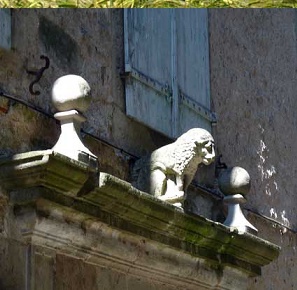





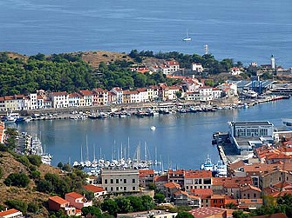
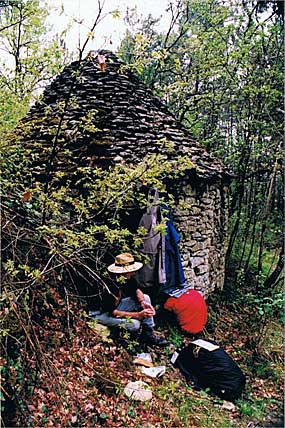

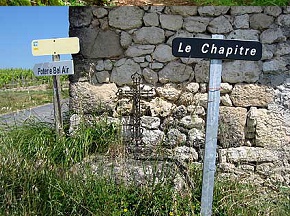





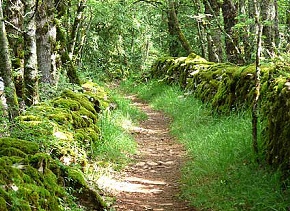










Mostly Walking...
... in France
France is criss-crossed by a network of pathways many of which have been used for centuries.
Some follow historic routes, perhaps a Roman road, an ancient pilgrim way or a traditional
transhumance route. Other routes have simply been used over the years by local people going about
their daily lives - to and from their farms, traveling to market or making a journey from town to town.
Sometimes the pathways have been designed to take in places of particular beauty or local interest.
The long distance footpaths are co-coordinated as the Sentiers de Grande Randonnée or GR's by
a national organisation called the Fédération Francaise de la Randonnée Pédestre (FFRP). The
FFRP is based in Paris and produces a comprehensive range of maps and guides. Good
mapping is also available from l'Institut Géographique National (IGN) which publishes many maps
including one which shows all the GR's throughout the country. This is the size of a tablecloth,
and spread to cover a table, can provide endless hours of planning or dreaming.
As an alternative to walking long distances on the GR's, you can combine daywalking with
car-based travel. Or perhaps, if you are staying in a particular area, daywalks can be part of the
overall holiday experience.
Menu of Long Walks
Some useful information...
return to Top
return to Top
return to Top
Visit SPAIN/PORTUGAL
Visit ITALY
Visit ROMANIA
Explore on MAPS
Return to HOME PAGE
Visit PHOTO GALLERIES
About walking in France
About long distance footpaths
About Day Walks
About long distance footpaths
About Day Walks
From le Puy to Conques
From les Eyzies to Cahors
Gorges of the Aveyron
The Dordogne and the Cere
Tour of the Haut Vivarais
Tour of the Vosges
From les Eyzies to Cahors
Gorges of the Aveyron
The Dordogne and the Cere
Tour of the Haut Vivarais
Tour of the Vosges
... or select a walk from
the MAP of walks...
Click for
Photo Galleries
of our French walks
Menu of Day Walks
The pathways wind through the forests and countryside or alongside little streams, sometimes
running between rough stone walls or skirting round a field of crops. Other times they follow forest
trails, farm tracks or minor roads. They pass through the ruins of uninhabited villages, negotiate
busy market towns and, less enjoyably, coincide occasionally with the busy roads of major towns.
Sometimes they run right through a farm, taking the walker into the centre of a farmyard with
yapping dogs and clucking chickens warning of your arrival.
We have found that there are two different ways to enjoying walking in France. You can follow one
of the long distance footpaths, for anything up to two or three weeks, staying in comfortable
accommodation each night or, if you prefer, camping out or using gite d'etapes or other
accommodation designed for walkers. You will enjoy the local regional cooking and set out each
morning in anticipation of new and different experiences that day and evening. Alternatively, you can
make a base somewhere and go out walking each day or combine walking with other activities.
However you choose to travel or stay, as a walker travelling in France, you will be rewarded by a
wonderful range of walking experiences.
Note: Some of our walks have previously appeared on French Moments, which is an excellent
site with lots of information about France.
With these tools you can plan a lifetime's walking. You could walk from the North to the South of
France, for example on the GR 5 which commences in Luxembourg and finishes at the
Mediterranean or the GR 7 which starts in the Vosges and continues to the Pyrenees. Or
travelling from West to East is the GR 10, a challenging route across the Pyrenees from the
Atlantic to the Mediterranean. The possibilities are endless. It is a common sight, in the map
shops of Paris, to see people browsing the shelves of topo guides deciding on their next
randonnée.
The waymarking, known as balisage, for the GR's is standardised across the country. Horizontal
bars painted in red and white are the reassuring sign that you are correctly following the route. An
arrow pointing to the left or right is warning of a change in direction and a cross of red and white
bars indicates that a route is not to be followed.
Local groups look after the pathways and the balisage in their regions. All have different styles -
sometimes neatly stenciled signage will appear at regular intervals, alternatively the paint may
have been slapped-on with drips left running down the tree trunk or wall. We once met a group of
well organised painting-walkers marking a route in the forests near Gevrey Chambertin in
Burgundy - each person had been allocated a paint pot or brush and they were bounding along
taking care not to drip the paint.
As well as the GR routes there are regional or local networks known as GRPs (sentiers de
grande randonées de pays) or PRs (sentiers de petite randonnée). These are similarly
waymarked but usually with red, yellow, orange or green balisage.
When we started walking we never booked accommodation. These days it is probably a good
idea, especially on popular routes. The web will be your source but you could well start with the
Logis de France chain which has family run hotels located throughout the countryside. Chambres
d'Hôtes (or B&B's) are another option, coordinated by two uniquely French organisations called
Gîtes de France and Chambres d'Hôtes France.
Finally, if you don't feel like making your own arrangements or walking with a backpack an
internet search will reveal a host of companies offering to guide you and carry your luggage from
place to place.
There is endless potential, just about everywhere, for interesting short walks that take in local
sights and countryside. Sometimes these will be in celebrated places of interest, even co-inciding
with the GRs themselves. More often they are local initiatives with booklets available in the local
tourist information offices or in stationers and bookshops.
Daywalking avoids the need to carry more than a daypack and allows you to come home to a
familiar base each night. You will venture into areas and see countryside you would otherwise have
missed. And you will pick up the local flavour of a particular community and gain a better
understanding and appreciation of rural life.
If cooking for yourself you can shop in the local markets, keenly anticipating market day in your
village or seeking out the markets in other towns. And when walking in the countryside you can
collect juniper berries and wild thyme to throw into the cooking pot.
The Internet is full of sites offering houses to rent ranging from simple cottages to castles. We
have enjoyed renting gîtes through Gîtes de France which coordinates the renting of gîtes rureaux.
Their properties are usually in rural areas with accommodation graded by épis (sheafs of wheat),
rather than by stars. Middle range ones, with 3 épis, are comfortable houses in rural villages with
fully equipped kitchens. There are a staggering number of gîtes in every département of France.
Pyrenees and Roussillon
Rhone-Alpes and Provence
Cezanne and Mt Ste-Victoire
Van Gogh and les Alpilles
Grand Canyon of the Verdon
Mt Ventoux and the Ouveze
Alpes Maritimes
Van Gogh and les Alpilles
Grand Canyon of the Verdon
Mt Ventoux and the Ouveze
Alpes Maritimes
The Massif Central
Gorges du Tarn
The Cevennes
Volcanoes of the Auvergne
The Cevennes
Volcanoes of the Auvergne
Burgundy and les Grand Crus